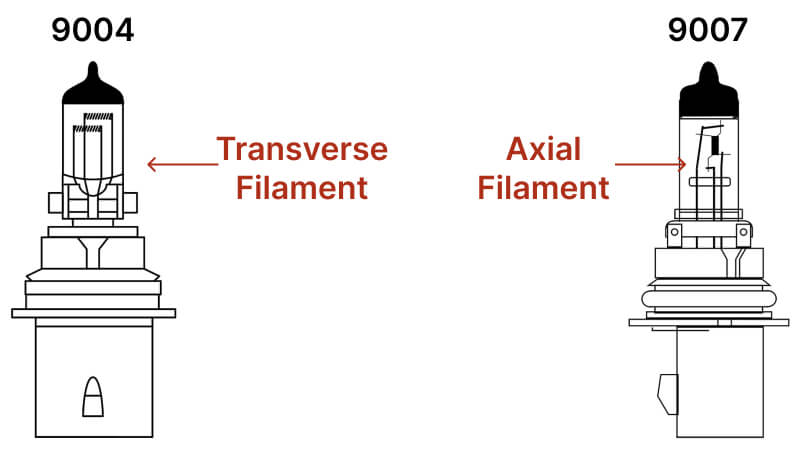9004 vs. 9007 Headlight Bulbs: Understanding the Differences
Introduction
In automotive lighting, the 9004 and 9007 bulbs may seem indistinguishable initially. Despite their similar exteriors, crucial differences can significantly impact their performance and suitability for various vehicles. This comprehensive guide explores the nuances that differentiate the 9004 and 9007 headlight bulbs.
Here's a quick overview table highlighting the disparities and commonalities between 9007 (HB5) and 9004 (HB1) bulbs.
| Bulb Size | 9007 Bulb | 9004 Bulb |
|---|---|---|
| Base Type | PX29t | P29t |
| Filament | Dual axial filament | Dual transverse filament |
| Wattage | 55/65 watts | 45/65 watts |
| Lumen | 1000/1350 lumen | 700/1200 lumen |
| Beam Type | Low/Hight beams | Low/Hight beams |
| Cross Reference | HB5 | HB1 |
Similarities Between 9004 and 9007
Before delving into the differences, let's recognize the shared characteristics between the 9004 and 9007 bulbs. Both feature a dual filament design, supporting both high and low-beam configurations. This commonality forms the basis for their interchangeability with some slight modifications.
Filament Design
9007's Axial Filaments
The 9007 bulb boasts axial filaments, aligned with the bulb's axis. This design choice impacts the way light is distributed, providing a unique lighting experience for drivers.
Arrangement of Filaments in the 9004 Bulb
In contrast, the 9004 bulb's filaments are arranged transversely, spanning across the bulb's length. This arrangement influences the dispersion and intensity of light emitted, contributing to the bulb's overall performance.
Impact on Light Distribution
The difference in filament design directly affects how each bulb illuminates the road. Whether axial or transverse, understanding this nuance is crucial for drivers seeking optimal visibility during various driving conditions.

Pin Configuration
Central Positioning of Ground Pin in 9007
Examining the pin configuration, the 9007 bulb features a central ground pin, flanked by high and low positive pins. This arrangement simplifies the electrical connections within the bulb, enhancing its efficiency.
Off-center Ground Pin in the 9004 Bulb
Conversely, the 9004 bulb places its ground pin to one side, while the remaining slots accommodate the high and low beam positive pins. The off-center ground pin adds a layer of complexity to the electrical setup.
Implications for Electrical Connections
Understanding the pin configuration is vital for proper installation and optimal functionality. Ensuring the correct setup is essential, especially for enthusiasts handling bulb replacements or upgrades.

Power Consumption
Power Rating for 9007
The 9007 bulbs feature a power rating of 55 watts for low beam and 65 watts for high beam.
Power Rating for 9004
In contrast, the 9004 bulbs have a wattage rating of 45 watts for low beam and 65 watts for high beam.
Efficiency and Visibility Implications
The additional 10 watts utilized by the 9007 bulb result in a marginally brighter low beam. This variance in power consumption may have implications for overall efficiency and visibility, with the 9007 bulb offering a slight advantage in brightness for the low beam compared to the 9004 counterpart.
Brightness Levels
Lumens Output for 9007 in Low and High Beams
9007 bulbs shine brightly with a light output of 1000 lumens in low beam and 1350 lumens in high beam configurations. This heightened brightness contributes to enhanced visibility during nighttime driving.
Lumens Output for 9004 in Low and High Beams
Comparatively, 9004 bulbs offer 700 lumens in low beam and 1200 lumens in high beam configurations. While still providing ample illumination, the difference in brightness is worth considering for those prioritizing visibility.
Significance of Brightness in Different Driving Conditions
The brightness levels play a crucial role in ensuring safety on the road. Factors such as weather conditions and road terrain should influence your choice between the 9004 and 9007 bulbs.
Compatibility
Interchangeability of 9004 and 9007 Bulbs
These two bulbs can be used interchangeably with some slight modifications. However, it's crucial to note that compatibility doesn't always guarantee seamless performance.
Modifications Required for Seamless Use
If you decide to use 9007 bulbs in a 9004 socket, or vice versa, ensure proper modifications for a secure fit. Understanding the intricacies of the connector pins is vital to prevent electrical issues.
Recommendations for Proper Connector Pin Setup
A pro tip for enthusiasts: When swapping between 9004 and 9007 bulbs, meticulously hook up the connector pins in the correct spots. This ensures optimal electrical connections and prevents potential malfunctions.
Advantages of 9007
Cost-Effectiveness
One of the notable advantages of the 9007 bulb is its cost-effectiveness. While providing efficient lighting, it often comes at a more budget-friendly price point compared to the 9004.
Common Usage in Modern Vehicles
The 9007 bulb is widely used in modern vehicles, contributing to its popularity. If you're driving a contemporary car, the 9007 might be a more readily available and compatible option.
Considerations for Upgrading from 9004
For those currently using 9004 bulbs, considering an upgrade to 9007 warrants careful consideration. Assessing the specific needs of your vehicle and your driving conditions is essential before making the switch.
Consideration for Choosing Between 9004 and 9007
Factors Influencing the Choice
Several factors influence the choice between the 9004 and 9007 bulbs. Consider aspects such as brightness preferences, power consumption, and compatibility with your vehicle's electrical system.
Personal Preferences and Driving Conditions
Your personal preferences and the typical driving conditions you encounter should guide your decision. Whether you prioritize brightness, energy efficiency, or cost, aligning the choice with your needs ensures a satisfying driving experience.
Conclusion
In conclusion, the 9004 and 9007 headlight bulbs share similarities such as a dual filament design and interchangeability with slight modifications. However, key differences, including filament design, pin configuration, power consumption, brightness levels, and cost-effectiveness, set them apart. When deciding between the two, it's essential to consider factors like compatibility, potential upgrades, and personal preferences to ensure the chosen bulb aligns with individual needs for optimal visibility and driving satisfaction.